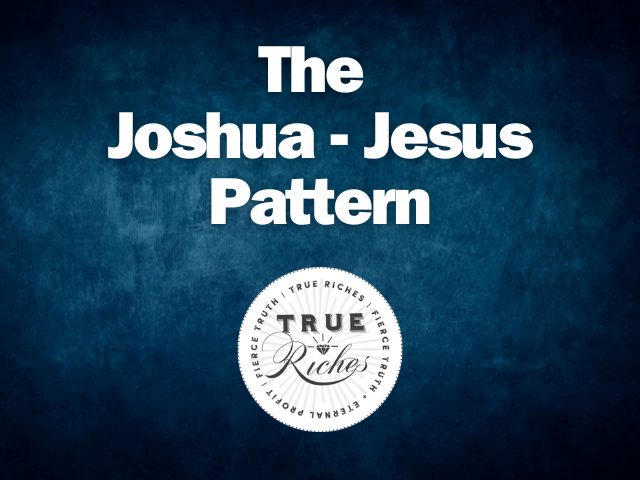
A Different Way to Read Joshua
What comes to mind when you think of Joshua from the Old Testament? If you are like most, you picture the sword-wielding warrior who succeeded Moses in leading the twelve tribes of Israel into their long-awaited promised land (Joshua 1:1-6). But what if Joshua’s story, as recorded in the Hebrew Scriptures, was never meant to glorify violent conquest? What if it was meant instead to point beyond itself to a greater “Joshua” who would lead humanity out of the spiritual desert and back into a spiritual paradise?
One Name, One Mission: “YHWH Saves”
The name of Christ in our English language is “Jesus.” It is simply the Greek form of the Hebrew name Yeshua, which we translate in English as “Joshua.” Both carried the same Hebrew name Yeshua, meaning “YHWH saves” (Numbers 13:16; Matthew 1:21). That alone should grab our attention. Here we have an old (or first) Joshua and a new (or second) Joshua. These two Joshuas shared one mission: to lead God’s people out of the wilderness and into promise. But there are clear differences if we insist upon a literal interpretation.
The first Joshua conquered his enemies with the sword of the flesh (Joshua 6–12). Conversely, the second Joshua wields the sword of the Spirit (Ephesians 6:17) and conquers His enemies through nonviolent love, never through homicidal violence (Matthew 5:44). Where Joshua took life, Jesus gave His own (John 10:11; Philippians 2:8).
The Foreshadowing of Christ in Joshua’s Life
A closer look at the first Joshua’s life—primarily in the book of Joshua—reveals it to be full of patterns that quietly foreshadow the second Joshua, Jesus.
From Moses to Joshua — From John to Jesus
Moses led Israel to the edge of the promised land but was unable to bring them in (Deuteronomy 34:4). Joshua finished what Moses had started. In the same way, John the Baptist prepared the way for Jesus (Matthew 3:1-3; John 1:23), but it was Jesus who brought humanity into the kingdom of God (Luke 4:43). Both Joshuas picked up where their forerunners left off.
Crossing the Jordan: Stepping into the New
Each began their role at the Jordan River. The first Joshua crossed the Jordan into Canaan (Joshua 3:14-17). Jesus entered the Jordan at His baptism, which marked the beginning of His mission (Matthew 3:13-17). Both moments symbolized stepping out of the old and into the new.
Twelve Tribes and Twelve Apostles
Joshua led twelve tribes (Joshua 4:4). Jesus called twelve apostles (Luke 6:13).
Joshua allocated the land of promise to the twelve tribes of Israel (Joshua 13–21). Similarly, Jesus delivered the mysteries of the Kingdom of God to the twelve apostles (Matthew 13:11; Mark 4:11).
Faith and Courage Over Fear
Joshua called his people to faith and courage, warning them not to fear the giants in the land (Joshua 1:6-9). Jesus did the same, calling His followers to trust God and not be afraid of the powers of this world (John 16:33; Matthew 10:28).
And the parallels keep going.
The Walls That Fall
When Jericho’s walls came crashing down, it was through faith and obedience, not brute force (Joshua 6:1-20; Hebrews 11:30). The pattern holds: Jesus came to destroy the wall of hostility that separated Jew and Gentile, slave and free (Ephesians 2:14-16; Galatians 3:28). Those walls came tumbling down at Calvary as the barriers created through religion and violence fell through faith and obedience (Romans 5:19), exposing forever the futility of homicidal power. In the same way, the walls that separate us from God and one another fall when we obey the words of Christ and love our enemies (Matthew 5:44; John 13:34).
The Living Stones of the New Covenant
Again, Joshua set up twelve stones in the Jordan as a memorial (Joshua 4:8-9).
Jesus built His church on twelve living stones—the apostles (Matthew 16:18; Revelation 21:14).
Joshua said, “Choose this day whom you will serve” (Joshua 24:15).
Jesus said, “You cannot serve two masters” (Matthew 6:24).
Reading Joshua Through the Lens of Christ
When read through the lens of Christ, Joshua’s violence turns symbolic. The enemies are not flesh and blood but pride, fear, and greed (Ephesians 6:12). The real conquest is inward. The promised land is the peace of God within (Philippians 4:7). The sword is the Word that divides truth from illusion (Hebrews 4:12).
The first Joshua’s mission ended in the dust of Canaan (Joshua 24:29-30). The second Joshua’s mission ends in resurrection (Matthew 28:1-6). One fought to obtain a land of promise. The other gave His life to redeem not just His friends, but even His enemies, including the entire world (John 3:16-17).
Once we see the pattern, we can’t unsee it… and we begin to read all of Scripture through the eyes of the One who saves us all.
Related Resources
(VIDEO) The Moses-Jesus Pattern: Amazing Similarities Between Moses and Jesus
(VIDEO) The Joseph-Jesus Pattern

